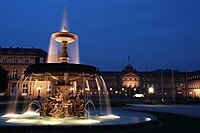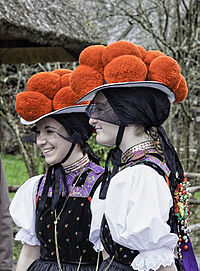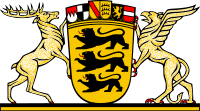Wikipedia:WikiProject Germany/Portal:Baden-Württemberg/Selected article
Selected article 1
Wikipedia:WikiProject Germany/Portal:Baden-Württemberg/Selected article/1

Maultaschen (singular ⓘ) is a traditional German dish that originated in the region of Swabia (in Baden-Württemberg). It consists of an outer-layer of pasta dough which encloses a filling traditionally consisting of minced meat, smoked meat, spinach, bread crumbs and onions and flavoured with various herbs and spices (e.g. pepper, parsley and nutmeg).
Maultaschen are similar to the Italian ravioli but are typically larger in size—each Maultasche being approximately 8-12 centimeters (3-5 inches across). They are almost invariably square or rectangular in shape.
On 22 October 2009, the European Union recognized Maultaschen (Schwäbische Maultaschen or Schwäbische Suppenmaultaschen) as a "regional specialty" and remarked that the dish is significant to the cultural heritage of Baden-Württemberg. This measure provides protection to the integrity of the dish, mandating that genuine Maultaschen are only produced in Swabia, a historical region that was incorporated into the modern German states of Baden-Württemberg and Bavaria.
Selected article 2
Wikipedia:WikiProject Germany/Portal:Baden-Württemberg/Selected article/2

Stuttgart (/ˈʃtʊtɡɑːrt/; German pronunciation: [ˈʃtʊtɡaʁt] ⓘ, Swabian: Schduagert [ˈʃd̥ua̯ɡ̊ɛʕt]) is the capital of the state of Baden-Württemberg in southwest Germany. The sixth-largest city in Germany, Stuttgart has a population of 600,068 (October 2014). Retrieved 17 Feb 2015 while the greater Stuttgart Metropolitan Region has a population of 5.3 million (2008), being the fourth-biggest in Germany after the Rhine-Ruhr area, Berlin/Brandenburg and Frankfurt/Rhine-Main. The city lies at the centre of a densely populated area, surrounded by a ring of smaller towns. This area called Stuttgart Region has a population of 2.7 million.
Stuttgart is spread across a variety of hills (many of them vineyards), valleys and parks – unusual for a German city and often a source of surprise to visitors who primarily associate the city with its industrial reputation as the 'cradle of the automobile'. Stuttgart has the status of Stadtkreis, a type of self-administrating urban county. It is also the seat of the State Parliament and State Government of Baden-Württemberg, the Evangelical-Lutheran Church in Württemberg as well as one of the two co-seats of the Roman Catholic Diocese of Rottenburg-Stuttgart.
Selected article 3
Wikipedia:WikiProject Germany/Portal:Baden-Württemberg/Selected article/3 Wikipedia:WikiProject Germany/Portal:Baden-Württemberg/Selected article/3
Selected article 4
Wikipedia:WikiProject Germany/Portal:Baden-Württemberg/Selected article/4 Wikipedia:WikiProject Germany/Portal:Baden-Württemberg/Selected article/4
Selected article 5
Wikipedia:WikiProject Germany/Portal:Baden-Württemberg/Selected article/5

A Bollenhut is a formal headdress worn since c.1750 by Protestant women as part of their local costume or Tracht in the three neighbouring Black Forest villages of Gutach, Kirnbach and Hornberg-Reichenbach. With its woollen pompoms, the picturesque-looking red Bollenhut has become a symbol of the Black Forest as a whole, despite its very local origins. The red pom-poms and white brim of the Bollenhut also is said to have inspired the top layer of the Black Forest Cake.
The broad-brimmed, whitewashed straw hat bears 14 prominent, woollen, pompoms arranged in the shape of a cross. Only eleven pompoms are visible, however, because three are covered by those on top. Spinsters wear red pompoms, married women wear black. The Bollenhut can weigh up to 2 kilogrammes and is manufactured by female milliners. The red Bollenhut may first be worn by girls at their confirmation.
Today the Bollenhut and associated Tracht are still worn on holidays and for traditional events. The Bollenhut and local costumes may be seen all year round e.g. in the Black Forest Costume Museum in Haslach im Kinzigtal.
Selected article 6
Wikipedia:WikiProject Germany/Portal:Baden-Württemberg/Selected article/6

The Murg Valley Railway (German: Murgtalbahn) is a 58 kilometre long railway line in the Northern Black Forest in Germany, that links Rastatt and Freudenstadt. It was opened in stages from 1868 to 1928 being built outwards from both Rastatt and Freudenstadt. The route through the narrow Murg Valley required the construction of numerous tunnels and bridges. The section between the stations of Baiersbronn and Freudenstadt Stadt is a steep ramp which is why it had to be operated until 1926 as a rack railway. Even today it can only be worked by vehicles that have the required approval.
After the occasional long-distance passenger services had been withdrawn in the 1990s, the Murg Valley Railway was integrated into the network of the Karlsruhe Stadtbahn between 2002 and 2004. Since then it has been operated by Albtal-Verkehrs-Gesellschaft (AVG), using their fleet of tram-trains. At Freudenstadt, these meet the services of the Ortenau S-Bahn (OSB), operating over the Kinzig Valley Railway to Offenburg.
Selected article 7
Wikipedia:WikiProject Germany/Portal:Baden-Württemberg/Selected article/7

The Blautopf (German for Blue Pot; "blau" means blue, "topf" means pot) is a spring that serves as the source of the river Blau in the karst landscape on the Swabian Jura's southern edge, in Southern Germany. It is located in the city of Blaubeuren, approximately 16 km (9.9 mi) west of Ulm. It forms the drain for the Blau cave system and feeds the river Blau, which after 14.5 km (9.0 mi), flows into the river Danube in the city of Ulm. Because of its high water pressure, the spring has developed a funnel-like shape, which at its deepest point has a depth of 21 metres (69 ft). The water's peculiarly blue color, varying in intensity due to weather and flow, is the result of chemical properties of limestone densely distributed in the water.
Numerous legends and folk tales refer to the Blautopf. Its characteristic colour was explained by the account that every day someone would pour a vat of ink into the Blautopf. Another myth stated that every time someone tried to measure the Blautopf's depth with a leaden sounding line, a water nix stole the sounding line. Therefore, it was not possible to determine the depth of the Blautopf. Because of this tale, there is a rock called Klötzle Blei ("little block of lead" in the local dialect) in the vicinity of the Blautopf.
Selected article 8
Wikipedia:WikiProject Germany/Portal:Baden-Württemberg/Selected article/8

The coat of arms of Baden-Württemberg was determined after the merging of the former German states Baden, Württemberg-Baden and Württemberg-Hohenzollern, that were divided due to different occupying forces after World War II, in 1952. The creation of the state was not without controversies and thus only the state colours black and gold were determined in 1952, but not yet the arms. The latter were only regulated in the Gesetz über das Wappen des Landes Baden-Württemberg (Law on the Coat of Arms of Baden-Württemberg) of 3 May 1954. Its use is moreover regulated by an order dated 2 August 1954. It was designed by Fritz Reinhardt.
The shield shows three black lions with red tongues on a golden background. The arms refer to the coat of arms of the Duke of Swabia whose House of Hohenstaufen had used these arms. The name of Suabia had long been discussed for use with the newly created state but it failed to be adopted due to resistance from parts of Baden.
Selected article 9
Wikipedia:WikiProject Germany/Portal:Baden-Württemberg/Selected article/9

The Federal Constitutional Court (German: Bundesverfassungsgericht; abbreviated: BVerfG) is the supreme constitutional court for the Federal Republic of Germany, established by the constitution or Basic Law (“Grundgesetz”) of Germany. Since its inception with the beginning of the republic, the court has been located in the city of Karlsruhe—intentionally distanced from the other federal institutions in Berlin (earlier in Bonn) and other cities.
The main task of the court is judicial review, and it may declare legislation unconstitutional, thus rendering them ineffective. In this respect, it is similar to other supreme courts with judicial review powers, yet the court possesses a number of additional powers, and is regarded as among the most interventionist and powerful national courts in the world. Unlike other supreme courts, the constitutional court is not an integral stage of the judicial or appeals process (aside from cases concerning constitutional or public international law), and does not serve as a regular appellate court from lower courts or the Federal Supreme Courts on any violation of federal laws.
Selected article 10
Wikipedia:WikiProject Germany/Portal:Baden-Württemberg/Selected article/10

The Danube Sinkhole (German: Donauversinkung or Donauversickerung) is an incipient underground stream capture in the Upper Danube Nature Park. Between Immendingen and Möhringen and also near Fridingen (Tuttlingen), the water of the Danube sinks into the riverbed in various places. The main sinkhole is next to a field named Brühl between Immendingen and Möhringen.
The term “sinking” is more accurate than “seeping”, because, instead of just distributing into the soil, the Danube’s water flows through underground caverns to the Aachtopf, where it emerges as the river Radolfzeller Aach.
The sinking Danube water disappears into a karst water system of the well-stratified limestone formation (the ox2 layer) of the White Jura and appears again in a horizontal limestone layer (the ki4 layer), approximately twelve kilometers away at Aachtopf. It then flows as Radolfzeller Aach into Lake Constance at Radolfzell. Thus, a part of the Danube water also flows into the Rhine. This geographical situation is a striking feature of the large European Watershed, which separates the catchment areas of the North Sea and the Black Sea.
Selected article 11
Wikipedia:WikiProject Germany/Portal:Baden-Württemberg/Selected article/11

The Venus of Hohle Fels (also known as the Venus of Schelklingen; in German variously Venus vom Hohlen Fels, vom Hohle Fels; Venus von Schelklingen) is an Upper Paleolithic figurine of a woman hewn from the ivory of a mammoth tusk that was located near Schelklingen, Germany. It is dated to between 35,000 and 40,000 years ago, belonging to the early Aurignacian, at the very beginning of the Upper Paleolithic, which is associated with the earliest presence of Cro-Magnon in Europe. This female figure is the oldest undisputed example of a depiction of a human being yet discovered. In terms of figurative art only the lion-headed, zoomorphic Löwenmensch figurine is older. The Venus figurine is housed at the Museum in Blaubeuren (Urgeschichtliches Museum Blaubeuren).
The Swabian Alb region of Germany has a number of caves that have yielded many mammoth-ivory artifacts of the Upper Paleolithic period. Approximately twenty-five items have been discovered to date. These include the Löwenmensch figurine of Hohlenstein-Stadel dated to 40,000 years ago and an ivory flute found at Geißenklösterle, dated to 42,000 years ago. This mountainous region is located in Baden-Württemberg and is bounded by the Danube in the southeast, the upper Neckar in the northwest, and in the southwest it rises to the higher mountains of the Black Forest.
Selected article 12
Wikipedia:WikiProject Germany/Portal:Baden-Württemberg/Selected article/12

Heart of Stone (German: Das kalte Herz, literally "The Cold Heart") is a fairy tale written by Wilhelm Hauff. It was published in 1827 in a collection of fairy tales that take place within the narrative of The Spessart Inn. It formed the basis for the East German film Heart of Stone, released in 1950.
Connections of this tale to the Romantic Era can be drawn. During this literary period it was quite common to write prose in fairy tale form. Drawing on the myth of the "glass-imp", Hauff presents the Romantic pursuit of happiness. Other Romantic characteristics include the use of the mystical-eerie, the uncanny and folk tales.
The key concept of Romanticism is the longing (Sehnsucht) that Coal-marmot Peter embodies, as he is granted three wishes throughout the story. What results from this longing is, as often seen in protagonists of Romantic works, self-destruction, since the riches Peter wished for crumble into misery and his longing degenerates into stinginess and spite. As the hopeless romantic that he is, Coal-marmot Peter does not give up on his quest for happiness and at the end of the fairy tale eventually finds this happiness with his wife.